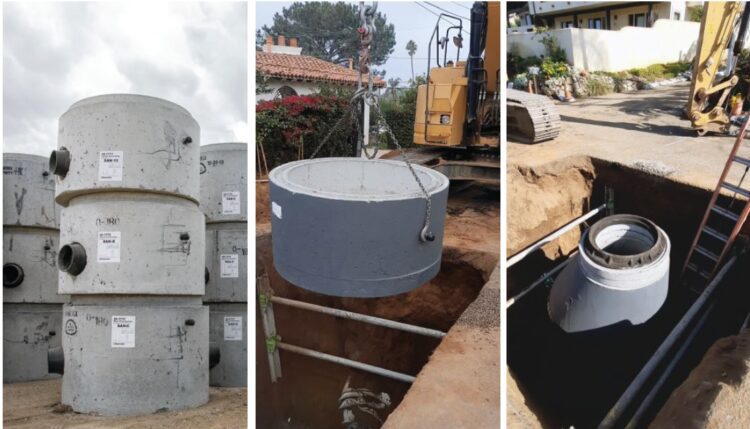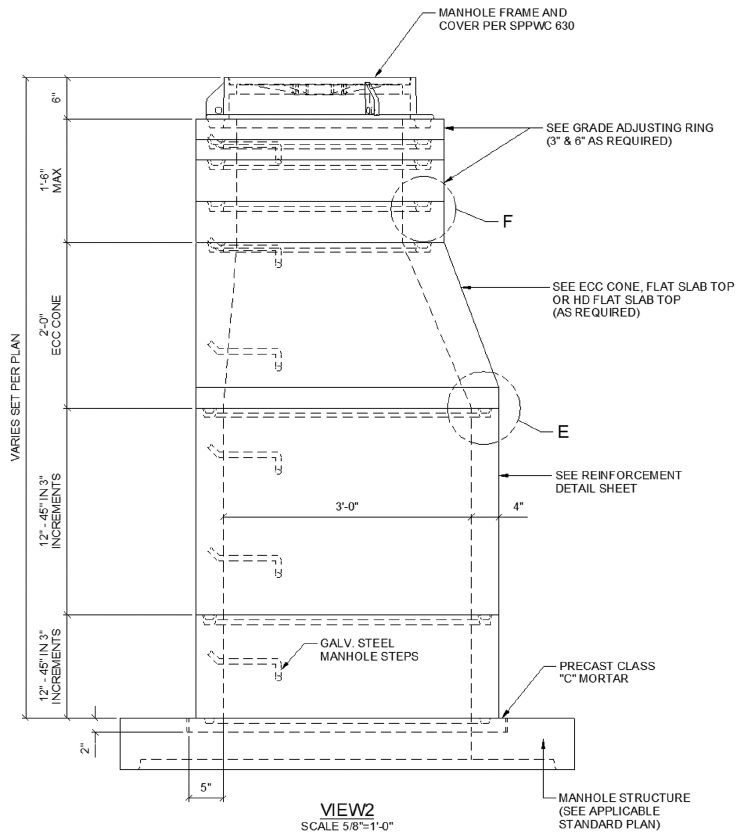Product Comparison: Precast vs. Cast-in-Place Manhole Base

Photos show precast manholes stacked for deployment (left), being lowered into place (middle) and ready for fill and grading (right).
Construction today is all about one word: impact. Low-impact construction is all about designing and producing a sequence and experience that will have the least effect on the existing landscape. That translates into a shorter construction process achieved via the mitigation of labor costs and resulting time savings. High-impact construction, however, can result in excessive time lost, jobsite waste and project disruptions.
When considering the impact of manhole base construction, I believe precast manhole base technology has surpassed the cast-in-place method in multiple ways. Let’s dive deeper to better understand why the structural engineer’s top choice for manhole bases should be precast.
Installation: Time Is Money
When on the jobsite, a simple glance at the two options tells the story. Precast arrives on the jobsite manufactured to the highest-quality standards in a controlled environment. In the facility, the manhole base is formed, quality-control checked and constructed. Easy, clean and low impact.
Conversely, in a pre-build timeline, cast-in-place has yet to be poured. As any cost expert knows, the longer construction takes place on the jobsite, the more problematic things can become. When dealing with wet concrete, everything from risers and soil variants in the hole on the site can cause a last-minute issue. Having to wait 24 to 48 hours for cast-in-place concrete to initially cure can present a major delay when it comes to impacting the site, the surrounding neighborhood, and overall time and money spent.
Precast concrete manholes are quickly and easily installed. At the end of the day, the bottom line with overall timing is a little more than one day for a precast installation, and more than two days for a cast-in-place installation. As all construction experts know: the longer the installation, the larger the cost.
Advantage: Precast
Labor: Less Is More
Finding and retaining skilled labor is an ongoing challenge across all facets of construction and manufacturing, and not one we’re likely to see end in the near future. With precast concrete undergoing manufacturing at the plant (and not relying on jobsite labor), simply installed (with fewer contractors needed than cast-in-place) and immediately backfilled, the choice is clear. Looking at the overall timeline, a precast crew will be able to complete the job and move to the next one faster, while the cast-in-place crew is just getting started.

A rendering showcases the easy, quick installation possible when choosing a precast manhole.
Advantage: Precast
Weather: Spec Product Wisely
According to NASA, extreme storms and precipitation are on the rise. Fortunately, when choosing precast concrete, weather shouldn’t delay production. Precast requires less time to get into the ground, which means less exposure to inclement weather conditions. Cast-in-place, and its 24- to 48-hour curing period, is likely to be far more affected by bad weather.
Advantage: Precast
Total Cost: Shorter Install Time = Smaller Budget
Add up the savings for installation and labor as well as factor in the time savings, and the choice is clear.
Advantage: Precast
Construction Waste: Choose Low Impact
Precast concrete manholes are manufactured in a plant in a controlled environment with accurately estimated rebar and concrete batching volumes. This translates to a lower level of waste. With cast-in-place, concrete washout, site clean-up and more can create a larger impact to post-installation waste. Choosing precast means there’s less product leftover for disposal and less jobsite mess to consider.
Advantage: Precast
Flexibility: Consider Your Jobsite
Precast can be regarded as the ideal made-to-order solution. In specific instances, however, cast-in-place concrete may be the better solution for a manhole with compromised space restrictions.
Advantage: Cast-in-place
Quality: All About Control
When you think about it, variables found on a jobsite that can affect overall quality (e.g., weather, soil composition, laborers with different expertise, joint sealing, curing conditions) are eliminated in the controlled environment of a manufacturing plant. Precast concrete manhole bases traditionally demonstrate distinctive uniformity and high quality that doesn’t waver from jobsite to jobsite.
Advantage: Precast
Nationwide Specs: No Problem
States bring to the table varying requirements regarding the necessary specs (sizes and shapes) of manhole bases. Both precast and cast-in-place meet all the needs here.
Advantage: Even
Overall Impact
Take a look at the inside of the finished product, including joint details in the base as well as the channeling, and you’ll more often than not encounter a higher degree of quality finish with precast. How each precast manhole base arrived in that finished state, however, is a different story.
Because the precast concrete manhole is prefabricated offsite, it’s ready to be set, sealed and backfilled the second it arrives on the jobsite. Precast is easier to install, offers important cost advantages, saves on labor, and results in less jobsite and post-installation waste. Cast-in-place can be a messier, more expensive and time-consuming process that brings with it multiple variables and unknowns. 
CASE STUDY
Minimizing Impact with a Shorter Construction Process
Project Type: Sewer Bypass Manhole
Location: Encinitas, Calif.
Owner: City of Encinitas
A Shift in Thinking
Southern California has traditionally been recognized as a predominantly cast-in-place manhole market. It’s the way it has always been done. A quick peek at the neighborhoods there reveals a large number of homes in very densely populated areas—and all these neighborhoods include manholes up and down the streets.
Construction companies are used to pouring out multiple bases at a time—it’s not unusual for them to cast-in-place up to seven bases in one day. When you’re talking impact from a time standpoint, the cast-in-place manhole process can be a time-consuming, high-impact, overnight process.

Southern California traditionally has used cast-in-place manholes.
Owners, managers and public-works departments that have relied historically on the cast-in-place methodology and process should consider the move to precast because, when investigated, significant time-saving cost/benefits to the end user are clear. With cast-in-place, more time on the job means more workers pouring concrete more often. On a construction site, time can be the biggest enemy … or the biggest windfall. The Encinitas jobsite is the perfect example of how precast saved time and labor at the end of the day.
A Busy Beach Municipality
Known as the flower capital of the world, Encinitas, Calif., is a beautiful little beach town 30 minutes north of downtown San Diego. Its increasing popularity, unsurprisingly, has brought with it more residents, more traffic and new challenges to the community’s infrastructure.
On this particular project, a sewer bypass manhole, the city had traditionally employed the cast-in-place method.
Using precast methods, contractors dig out an existing space, insert the manhole base into the hole and connect it to both ends of the bypass.
Keep in mind, this is all happening in the middle of a residential street in a busy beach community, where neighbors probably aren’t crazy about their roads being shut down, the ensuing traffic buildups and the continued negative impact to their everyday routines. Therefore, as with any neighborhood project anywhere in the country, it was crucial the construction team be in and out of this location as quickly as possible.
Precast Performance
When considering product selection for a metropolitan street jobsite, precast is the better choice to avoid disruption to residential roads. Cutting asphalt and digging the hole take the same amount of time for precast or cast-in-place, but the next steps reveal the time and labor savings.
With precast, backfilling happens the first or second day, and there’s no waiting 24 to 48 hours for the cast-in-place concrete to dry and set.
Manhole bases typically come with a built-in riser—a bonus for precast—as no additional trips to and from the truck to grab another riser are needed. And once again, precast comes with no waiting for concrete to set and dry. Less trips to the truck plus clear time savings equals a more-efficient jobsite.
At the Encinitas site, the total time from start to finish was 14.75 hours for precast vs. an estimated 40 to 42 hours for cast-in-place (see accompanying chart).
Labor Costs Reduced by 25 Percent
Some years ago, at a jobsite in Escondido, Calif., the local county required approximately 350 cast-in-place A-4 cleanouts. The contractor learned that if he converted 250 of the cast-in-place cleanouts to precast, during the two-week period of construction he could carve about 2.5 days back out of his schedule. Simply because precast would allow for the digging of multiple holes (and the plating of them), with a crew returning the next day to clean each site, rock them, set the cleanouts, stack out risers and finish grade.
This example shows again the many benefits (e.g., schedule savings, time savings, labor savings, etc.) available when a precast manhole is specified for a jobsite.
Turning the focus back to the Encinitas site; choosing precast required two or three workers maximum, while cast-in-place in the same situation probably would have required at least four workers and potentially for a longer amount of time. The result is an estimated 25-percent savings on labor with the precast option. With today’s ongoing skilled-labor shortfalls, this could have a major impact on budget and scheduling.

The Final Test
The final test for any manhole job is the vacuum test, and passing or failing will have an impact on the total cost of the job. Vacuum tests on a precision joint (i.e., precast) are traditionally much less likely to fail. Cast-in-place joints are formed by hand with active concrete, increasing the chance of potential inconsistencies and imperfect seals, which could lead to leaks and failed vacuum tests.
When it’s time to specify products for manhole installations, consider the entire picture and specify the solution that provides clear savings across the board.
A rendering showcases the easy, quick installation possible when choosing a precast manhole.
About Bob Vildibill
Bob Vildibill is the regional sales manager/Southern California for Oldcastle Infrastructure; email: [email protected].


